Fognails
CFBT-US has just taken delivery of two Low Pressure Fognails manufactured by Waterfog AB, in Sweden. Fognails are small piercing nozzles with a flow rate of 70 lpm at 8 bar (18.49 gpm at 116 psi). Low Pressure Fognails have a maximum working pressure of 20 bar (290 psi) which will allow operation at pressures well above 100 psi for reduced droplet size and a somewhat higher flow rate For example, the Fognail will deliver approximately 91 lpm at 12 bar(24.28 gpm @ 200 psi). These Fognails will be used in field trials conducted by Central Whidbey Island Fire & Rescue (CWIFR).
The Fognail shaft is 17 mm (0.67 in) in diameter and 530 mm (20.75 in) long and is pointed on one end with a reinforced striking surface on the other end. Water enters the Fognail through a pipe welded to the shaft just ahead of the striking surface. A 25 mm (1 in) threaded connection is provided. The threads are standard 1 in IPT (iron pipe thread). As received from the factory, the Fognail is fitted with a stainless steel ¼ turn valve which may receive and adapter for any type of hose connection.
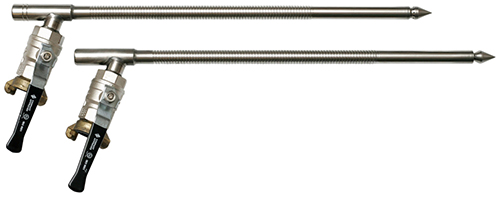
Waterfog AB http://www.waterfog.se/sida1.html
The Fognail shaft is 17 mm (0.67 in) in diameter and 530 mm (20.75 in) long and is pointed on one end with a reinforced striking surface on the other end. The Fognail shaft has coarse, straight cut threads on the shaft to assist in holding the Fognail in place when flowing water. Water enters the Fognail through a pipe welded to the shaft just ahead of the striking surface. A 25 mm (1 in) threaded connection is provided. The threads are standard 1 in IPT (iron pipe thread). As received from the factory, the Fognail is fitted with a stainless steel ¼ turn valve which may receive and adapter for any type of hose connection.
Fognails are typically inserted through the roof or an exterior wall. The initial opening is created using a spike hammer and the Fognail is then driven into place. CFBT-US decided to forgo the spike hammer as a Halligan or pick head axe could be used and serves multiple purposes.
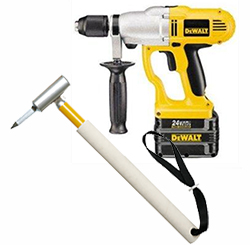
Alternately, a battery operated hammer drill with both wood an masonry bits provides a quick and effective alternative for creating an access point for a Fognail
Attack and Restrictor
There are two types of Fognail, Attack and Restrictor. Both types of Fognail have a pointed tip, but the location and size of the orifices differ based on application. The Attack Fognail has 16 orifices at the tip and produces a 30o Fog Cone with a reach of 8 m (26.25 ft). The Restrictor has 32 orifices at the tip designed to provide impinging streams that produce a circular pattern of water fog 10 m (32.81 ft) in diameter and projecting a distance of 5 m (16.40 ft).
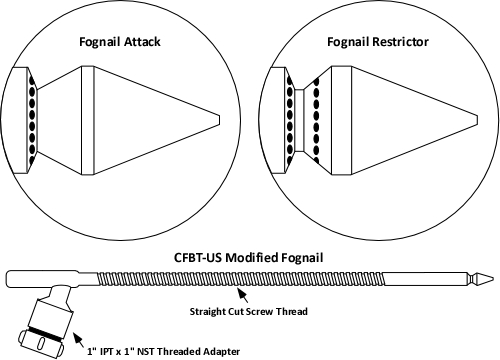
CFBT-US has modified the standard Attack and Restrictor Fognails by replacing the quarter turn valve at the nozzle inlet with a 1 in Iron Pipe Thread (IPT) x 1 in National Standard Thread (NST) Adapter to allow the Fognail to be supplied by 1 in hose equipped with NST couplings. Use of a short section of 1 in hose allows greater flexibility and reduces the weight of the charged line exerted on the back of the Fognail when it is in use. As modified by CFBT-US, the short section of 1 in hose is extended off a break-apart combination nozzle on a 1-3/4 in hoseline using a 1-1/2 in NST x 1 in NST adapter. The nozzle shutoff is used to control water flow to the Fognail.

Concept of Operations
Fognails are used to introduce water in the form of small droplets into enclosed areas without the need for a large opening that would increase ventilation and the flow of air to the fire. Given the small droplet size from this nozzle, it is likely that water applied through a Fognail has the effect of gas cooling (vaporization while traveling through hot gases) and indirect attack (vaporization on contact with surfaces).
Tactical Flow Rate for Indirect Attack
Tactical flow rate requirements can be estimated using a variety of methods (most of which are used in training, but not on the fireground). The most useful method in considering the extinguishing capability of Fognails is the Iowa Formula, which was developed for the indirect method of fire attack. This formula determines the flow (in gallons) required for 30 seconds in order to achieve fire control (not extinguishment).

If the flow rate from a Fognail is estimated as 20 gpm (76 lpm) and the Iowa Formula is solved for volume (Length x Width x Height), a single Fognail can control a fire in a compartment having a volume of 2000 ft3 (56.63 m3) with a 30 second application. With a ceiling height of 8’, this would be a 250 ft2 (23.23 m2) compartment. Note that control in a larger volume may be possible with a longer application (e.g., 60 seconds).
For more information, see Estimating Required Fire Flow: The Iowa Formula.
Fognail Tactics
Fognails are not intended to be used as the sole method of water application in firefighting, but are integrated with other offensive or defensive firefighting tactics, depending on the circumstances. Consider the use of Fognails as a fire control (not extinguishment) tool.
Attic Fires: Fognails provide several options for dealing with attic fires. One or more Restrictor Fognails may be inserted in the roof if it is stable enough to work on. Alternately, a combination of Restrictor and Attack Fognails may be used to cover a larger area or volume of attic space.

As an alternative to working from the roof Attack Fognails may also be used through the eaves (existing or drilled openings) or from the gable ends of the roof.
Fognails may also be used defensively to develop a barrier to fire spread to uninvolved areas of a larger attic space. In this application, multiple Fognails are placed to produce a dense barrier of water fog to serve as a fire break. Note that this may not be an absolute barrier and should be supported by interior handlines to check for extension.
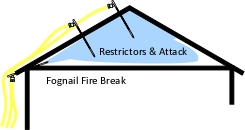
Fires in Void Spaces: Fognails provide an effective tactic for controlling fires in void spaces. In this application, Fognails may be inserted into the void space from the exterior or interior. However, if used on the interior, crews placing the Fognail(s) must be protected by a standard handline.

Unvented Compartment Fires: When a compartment fire has self-vented, a brief application of water from the exterior may be the fastest way to reduce the heat release rate (HRR). In other cases, it may be faster to directly initiate an interior attack. However, when staffing is limited and there is no known imminent threat to live (i.e., reported or visible occupants), operation from the exterior may be the only acceptable option. Under these circumstances, firefighters may be presented with a challenging decision. If water cannot be applied into the fire compartment from a door, do they break a window to allow exterior application of water? Breaking a window provides access for water application, but also increases ventilation. In addition, unlike a door which may be closed after water application, a window cannot be unbroken and the increased ventilation may allow fire growth in areas beyond the reach of the stream applied through the window.
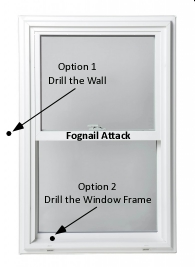
Use of a Fognail allows firefighters to introduce water into the fire compartment without increasing ventilation. In this case the Fognail (or nails) would be inserted through the exterior wall or window frame into the fire compartment. If multiple compartments are involved, multiple fog nails may be required or the initial fog nail may be move from one location to another.
Next Steps
CWIFR will be training in the use of Fognails and will conduct live fire training designed to provide members with an opportunity to use Fognails under realistic conditions. More information to follow as it develops!
Tags: Fire Control, nozzle techniques



October 21st, 2013 at 04:58
Great stuff!
One of its best application is fighting fires in void spaces and inside walls/trusses.
Keep up the good work!
Stefan
October 24th, 2015 at 01:46
Hi, I work at Fire and Rescue NSW (Australia) and we are looking into trailing this. I would love to know how you guys went and if you were happy with this tool?? Any feed back would be very helpful. Thanks. kind Regards, Sara